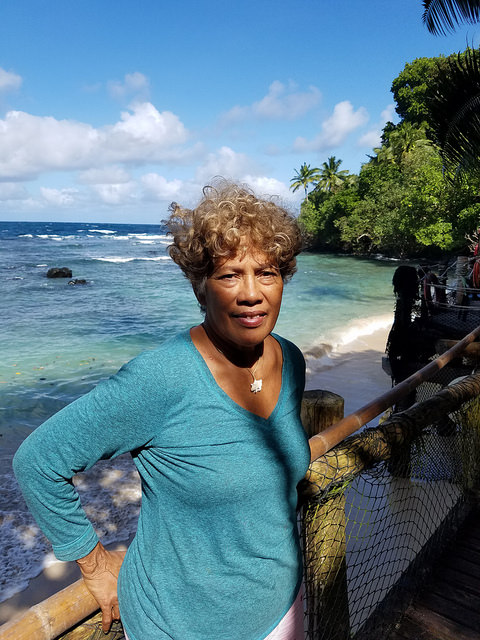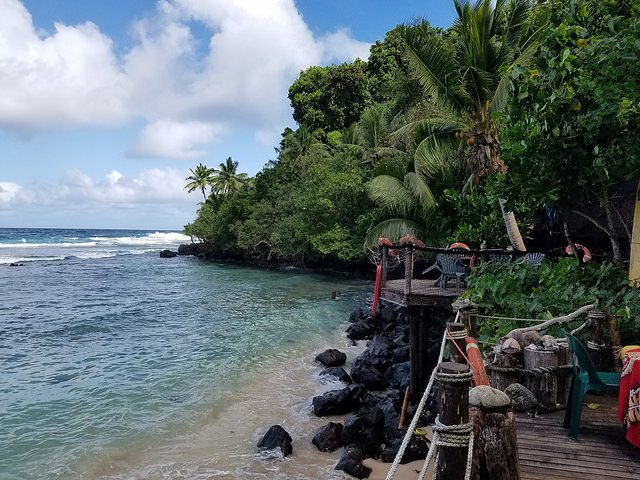 The Alega Marine Sanctuary in American Samoa is a special place. It’s a place where turtles lay their eggs on the beach, sharks swim around the bay and young corals grow everywhere. Not too long ago, however, the local coral reefs had been devastated by overharvesting and pollution. What changed to allow these reefs to recover? Tisa Fa’amuli, a native Samoan and self-described eco-warrior, decided to take it upon herself to restore the reef. She created a website to raise awareness about the Sanctuary and expressed her mission to CORAL Board Member Michael Bennett, who recently visited American Samoa and had the opportunity to document and share Tisa’s inspiring story.
The Alega Marine Sanctuary in American Samoa is a special place. It’s a place where turtles lay their eggs on the beach, sharks swim around the bay and young corals grow everywhere. Not too long ago, however, the local coral reefs had been devastated by overharvesting and pollution. What changed to allow these reefs to recover? Tisa Fa’amuli, a native Samoan and self-described eco-warrior, decided to take it upon herself to restore the reef. She created a website to raise awareness about the Sanctuary and expressed her mission to CORAL Board Member Michael Bennett, who recently visited American Samoa and had the opportunity to document and share Tisa’s inspiring story.
Tisa Fa’amuli’s story starts on the island of Tutuila where she was born and raised by her father Afenoa. Being the second of twelve children, Tisa learned many lessons from her father about working hard, providing for a large family and respecting the land. “This is where I learned about conservation,” Tisa notes. While growing up in the 50s, “these words were not used: conservation, sustainable. We lived it. We didn’t identify them. It was a way of life. It was a way for survival.” These lessons stuck with Tisa and shaped her future in unexpected ways.
 At the age of 34, after numerous years living away from home, Tisa moved back to her hometown of Alega from San Diego, California and didn’t recognize her childhood village. The fish in the bay were gone, the coral reefs were dead and the beaches were covered in debris. Tisa soon realized “that this village needs to be restored.” To help kick start restoration efforts, Tisa and her two sons started clean-ups along the coastal highway and beaches. Local community members thought she had lost her mind “because nobody cleans the highway; it’s the government’s job.”
At the age of 34, after numerous years living away from home, Tisa moved back to her hometown of Alega from San Diego, California and didn’t recognize her childhood village. The fish in the bay were gone, the coral reefs were dead and the beaches were covered in debris. Tisa soon realized “that this village needs to be restored.” To help kick start restoration efforts, Tisa and her two sons started clean-ups along the coastal highway and beaches. Local community members thought she had lost her mind “because nobody cleans the highway; it’s the government’s job.”
It was around this same time in 1980 that Tisa decided to start protecting a small strip of beach and coastal waters near her property, creating a self-declared marine sanctuary. Her goal was to restore the local marine life back to what it was when she was a child. She created her own no-take zone that was largely enforced by word of mouth and a variety of self-enforcement methods. She and her partner, Candy Mann, performed night patrols looking for poachers and used flash lights to scare them away, sometimes even getting in a kayak to chase them off of the protected area. In 1989, inspired by these experiences, Tisa started Tisa’s Barefoot Bar & Eco-Resort, using the profits to help fund her conservation efforts.
 Over the years, Tisa learned to use education and outreach as an effective tool for protecting her special sanctuary and gaining local buy-in. By speaking with local fishermen and villagers, she could convince them about the importance of caring for the marine environment, not catching baby fish, or not catching entire schools of fish. “I would just engage them in conservation and have them really feel my heart as a sincere way (not) to come and destroy or kill the reef, walk on the reef (or) try to get the fish” explains Tisa. “I put it in forms of education that they understand.”
Over the years, Tisa learned to use education and outreach as an effective tool for protecting her special sanctuary and gaining local buy-in. By speaking with local fishermen and villagers, she could convince them about the importance of caring for the marine environment, not catching baby fish, or not catching entire schools of fish. “I would just engage them in conservation and have them really feel my heart as a sincere way (not) to come and destroy or kill the reef, walk on the reef (or) try to get the fish” explains Tisa. “I put it in forms of education that they understand.”
In order to ensure that these life lessons get passed down to future generations, Tisa has started training her grandchildren on how to protect the reef and has shared stories from her father about always caring for the land and taking pride in your roots. Thanks to Tisa’s time and effort, in 2013, the local government officially created a no-take Marine Protected Area (MPA) with a stated goal to “educate other communities how to start Marine Sanctuaries to protect our beautiful islands and education on indigenous fishing seasons and methods.” Tisa’s future goal is to have a place that is open to local people to come, learn and enjoy marine life in perpetuity, and, through her hard work and dedication, she has created just that opportunity.